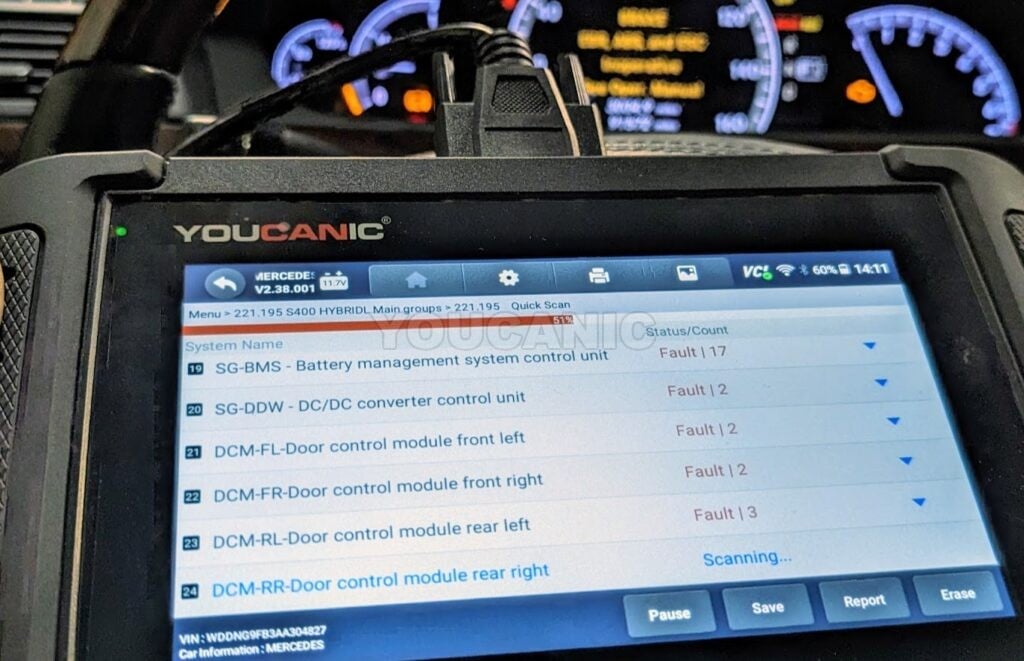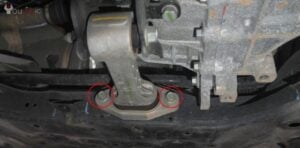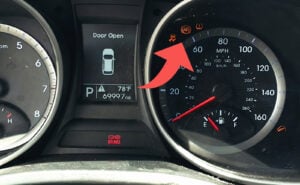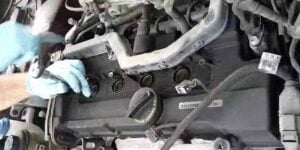Hyundai ABS & Traction Control Light Stay On – Common Problems
The ABS light in your Hyundai alerts the driver and requires immediate attention. Knowing the common causes of why your ABS light is turned on is important to determine the problem’s source. This article explores the common causes and symptoms, how to reset the ABS light, and provides practical solutions to address them effectively.
What does the ABS light mean on a Hyundai?

The Anti-lock Braking System (ABS) in your Hyundai Elantra, Sonata, Tucson, Santa Fe, and many more models regulate hydraulic braking pressure to prevent the brakes from locking up during sudden braking. It is an important safety feature that prevents accidents in slippery road conditions and shortens the braking distance during emergency braking.
The ABS comprises different parts and sensors that work together to work properly. When one or more components fail or malfunction, The ABS light turns on and alerts the driver that there is a problem in the system. It is important to determine and solve the problem immediately to ensure the reliability of your anti-lock braking system.
Symptoms

- ABS Light Stays On – ABS light is always on
- ABS, TCS, and ESC lights are ON – ABS, TCS, and ESC lights are simultaneously on
- Brake Fluid Leaking From ABS Pump – There is a leak coming from the ABS pump
- Check Auton Emergency Braking System Warning Message
Common Causes
There are several reasons why your ABS light turns on. The most common is the ABS wheel speed sensor failure. This part is very cheap and easy to install, and you can do it yourself. Other causes include a low brake fluid level, a dying battery, a damaged wire, and many more.
Faulty ABS Wheel Speed Sensor

The ABS wheel speed sensor detects the speed of each wheel, allowing the ABS module to regulate the hydraulic pressure accurately and prevent the brakes from locking up. If one or more wheel speed sensors are faulty, they send inaccurate signals to the ABS module, thus turning the ABS light on.
The wheel speed sensor is prone to dirt and debris that can block it from accurately detecting the wheel speed. Cleaning the sensors can sometimes resolve the ABS light. A faulty wheel speed sensor is also very easy to replace and can only cost around $30.
ABS Module Failure

The Anti-lock Braking System module is the brain of the entire system. It monitors all the sensors and controls the hydraulic braking pressure to prevent wheel lock-up during hard braking.
A faulty ABS module results from a short circuit within its inside circuit, illuminating the ABS light. Moisture can cause internal circuit failure. This is caused by worn-out weather seals that allow moisture to enter the module. Another is the brake fluid, which can leak internally and cause short circuits.
Damaged Steering Angle Sensor

The steering angle sensor monitors the direction of the vehicle’s turn. The ABS module needs to know this direction to regulate the braking pressure and accurately prevent brake lockup.
The Traction Control System (TRC) also uses the steering angle system. When the steering angle sensor is faulty, the ABS light accompanies the TRC light. Also, when the battery is recently replaced, and the ABS and TRC lights illuminate, it is possible that the steering angle sensor needs to be calibrated.
Damaged or Dirty Tone/Reluctor Ring

The ABS wheel speed sensor uses the reluctor ring to detect each wheel’s speed accurately. Over time, dirt and mud can build up between the teeth of the reluctor ring, leading to an inaccurate reading of the wheel speed and turning on the ABS light. This can be easily solved by cleaning the ring to remove any dirt build-up. When the reluctor ring is damaged, the wheel speed sensor cannot detect the wheel speed, disrupting the signal sent to the ABS module.
Weak Battery

Like any other electrical system in your vehicle, a batterysupplies steady power to the anti-lock braking system. If the voltage is below 9.5 Volts, the ABS module cannot function correctly, and the sensors will send incorrect data, thus turning the ABS light on. Replacing the battery if it supplies low voltage to ensure the ABS’s operability is important.
Damaged Wires and Connectors

The wires and connectors of the anti-lock braking system are prone to damage and corrosion. This prevents sensor signals from reaching the ABS module, thus turning the light on. Wires can be easily damaged by debris from the road. The wheels can also damage them by rubbing against them. Moisture can corrode connectors.
Blown a fuse or Bad Relay

The ABS fuse protects the entire anti-lock braking system from power surges. It disconnects the ABS from the battery to prevent damage to the module’s internal circuits and turns on the ABS light. When a fuse is blown, the system has a short circuit. Knowing where the short circuit comes from before replacing a new fuse.
Low Brake Fluid Level

The anti-lock braking system uses brake fluid to regulate the hydraulic braking pressure to prevent the brakes from locking up. A low brake fluid level can prevent the ABS from engaging during sudden braking and will turn on the ABS light.
A couple of factors can result in a low brake fluid level. Worn-out brake pads can reduce the brake fluid level. This can be resolved by topping up the brake fluid level to full. But when there is a leak within the braking system, it is important to address it immediately to prevent the loss of function of your braking system.
Safety Recall
Hyundai has issued a recall related to ABS module short circuits in certain vehicles. This ensures that the ABS functions correctly, reducing the risk of accidents caused by system malfunctioning. Here is a list of some of the Hyundai models that have been affected by ABS module recalls:
- Hyundai Sonata (2006-2011)
- Hyundai Azera (2006-2011)
- Hyundai Elantra (2009-2010, 2019-2020)
- Hyundai Santa Fe (2007-2009)
- Hyundai Veracruz (2007-2008)
- Hyundai Genesis Coupe (2010-2016)
- Hyundai Tucson (2014-2015)
- Hyundai Veloster (2013-2015, 2019-2021)
- Hyundai Kona (2019-2021)
It’s important to note that this list is not comprehensive, and additional models or years may be affected by ABS module recalls. If your vehicle is affected by the recall, contact the Hyundai service center. To check if your vehicle is affected, click here.
Troubleshooting & Reset Procedure

Use the YOUCANIC scanner to diagnose Hyundai ABS and traction control system problems.
- Locate the OBD II port under the dash of your vehicle. It is usually located near the driver’s side and is a 16-pin connector.
- Plug in the scanner and turn on the ignition, but do not start the engine.
- Select the make of your vehicle from the list of available makes. You can select “Auto Detect VIN” to automatically detect your vehicle’s make and model.
- Select “Control Units,” then “ABS/Traction Control Module.” Remember that the name of this module may vary depending on the make and model of your vehicle.
- Once the scanner is on, select “Diagnostics” from the main menu.
- Once you have selected the ABS/Traction Control Module, you can select “Read Codes” to see any stored trouble codes related to the ABS. The scanner will display the current codes, which will help you determine what may be causing the ABS and traction control warnings to turn on.
- Based on the codes, the scanner may suggest performing further tests or inspecting certain components of the ABS, such as the wheel speed sensors, brake lines, and hydraulic control unit.
- Once the underlying issue has been fixed, then select Clear Codes to clear fault codes stored in the ABS control unit and reset ABS and traction control warning lights.
Frequently Asked Questions
Is it safe to drive with the ABS light on in my Hyundai?
Driving with the ABS light on is not recommended, as the anti-lock braking system may not function properly. This can lead to decreased braking performance, loss of stability control, or increased stopping distances. It’s best to have the issue addressed as soon as possible.
Can I still use my brakes if the ABS light is on in my Hyundai?
You can still use your brakes if the ABS light is on. However, you may experience decreased braking performance, and the anti-lock braking system may malfunction. It’s best to diagnose and repair the issue as soon as possible.
My Hyundai Santa Fe’s ABS light is on, is it covered in the recall?
To determine if your Hyundai Santa Fe is covered under a specific recall related to the ABS, you would need to provide the year and model of your vehicle. There have been several recalls related to the ABS in Hyundai vehicles over the years, affecting various models and model years.
Alternatively, you can contact your local Hyundai dealership or the Hyundai customer service hotline to inquire about applicable recalls and whether your vehicle is affected. It’s important to address any issues with the ABS system as soon as possible to ensure your and your passengers’ safety while driving.
How much does it cost to fix the ABS in a Hyundai?
The cost to fix the ABS in a Hyundai can vary depending on the issue. A blown fuse or bad relay may cost less than a damaged wire or faulty ABS module.
Fault Codes
- C1203 – ABS Pump Motor Voltage Low
- C1204 – ABS Pump Motor Voltage High
- C1205 – ABS Inlet Valve Coil Front Circuit Short To Battery
- C1206 – ABS Inlet Valve Coil Front Circuit Short To Ground
- C1207 – ABS Inlet Valve Coil Rear Circuit Short To Battery
- C1208 – ABS Inlet Valve Coil Rear Circuit Short To Ground
- C1210 – ABS Pump Motor Circuit Malfunction
- C1211 – ABS Pump Motor Overrun Condition Detected
- C1233 – ABS Sensor Right Front Input Signal Missing
- C1234 – ABS Sensor Left Rear Input Signal Missing
- C1235 – ABS Sensor Right Rear Input Signal Missing
- C1236 – ABS Sensor Left Front Input Signal Missing
- C1260 – ABS Hydraulic Pump Motor Relay Circuit Failure







